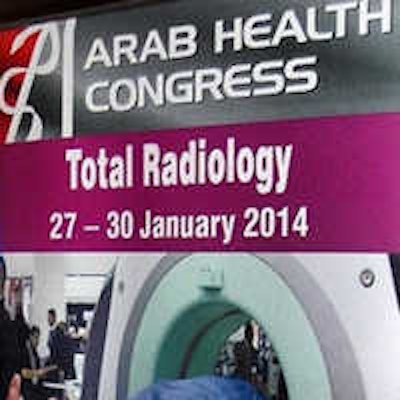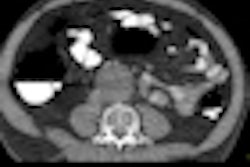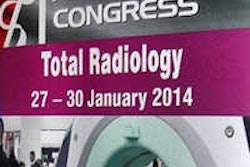
DUBAI - Not long ago, being a radiographer/radiologic technologist meant being an x-ray technician with limited responsibilities. But technology, demographics, and the rapidly evolving needs of the imaging department have changed the picture globally -- and especially in the United Arab Emirates (UAE), according to a presentation at Arab Health 2014.
Today's hospital radiology departments in the UAE need all the skills they can get. To acquire many of them, they rely on a too-small army of female radiologic technologists, who are doing everything from calming patients' fears to administering PACS networks to conducting research on department workflow and the patient experience. Along with increasing stress, they are finding enormous opportunities for advancement.
"We are communicators with patients, staff, and leaders of the department," said Jobby Ann Abraham from the University of Sharjah. "We are performers. We handle equipment to produce good images. We are investigators. We talk to the patient about their clinical history and then we go ahead and select the appropriate equipment and technique. ... We are problem solvers and protectors. We protect our patients, our staff, our department from radiation, and in the end we're [trainers] as well."
Growth of the technologist's role
In the past in the UAE, men operated machines, but owing to sweeping changes in recent years, technologists' roles have grown exponentially. Digital radiography and ongoing innovation are among the forces that have completely changed the profession, and in every hospital in the UAE, female technologists are more in demand than men, said Abraham, who is a clinical tutor in the diagnostic imaging department.
Today's technologist job description can encompass that of CT and MRI technologists, radiographers, PACS administrators, researchers, and application or product specialists, she said. Diagnostic radiologic technologists work in every imaging modality, in the imaging suite and the operating theater, and in administration and management.
"And of course at universities we are professors, lecturers, and tutors," she said.
 Jobby Ann Abraham from University of Sharjah.
Jobby Ann Abraham from University of Sharjah.
Within the department and with patients, the most important role of the UAE technologist is radiation protection.
"Within the department we're supposed to follow the protocols of the hospital and the hospital policies," she said. "And as a radiographer, we should be able to practice radiation safety, infection control, and quality assurance tests in the department. It's also very important to embed teamwork and regular CME courses."
Communication with the patient is another top priority, allowing technologists to help identify their problems, explain why the images were requested, and make the patient comfortable in part to avoid having to repeat the exam.
Technologists should be adept at working with patients of all ages and demographics and with all disease types. If a patient walks in with a leg cast, the technologist must be able to perform the exam without causing undue discomfort to the patient.
"Importantly, we maintain patient confidentiality, protection, and safety," Abraham said.
Clinically, technologists must maintain a clean work environment, using masks, gloves, and shields when appropriate. They should be able to evaluate imaging protocols and have sufficient knowledge of anatomy, physiology, and math to produce acceptable diagnostic images consistently, selecting the appropriate equipment, accessories, and exposure factors, Abraham said.
"When we are working with the equipment, we should know how much the kV should be increased or decreased -- this is all a part of radiation protection," she said.
Technologists must also be adept at image processing, and they should be able to critique images, determine whether an image is of good quality, and, finally, complete postprocedural tasks.
"As we all know, radiography's needs are constantly evolving, with demand [growing] for more highly skilled radiographers," Abraham said. In training roles, "we should be capable of being good presenters and highly skilled radiographers as well."
Regular CME meetings, clinical seminars, and clinical training are some of the educational tasks radiographers must complete to continue improving their knowledge. Good clinical judgment, independence, and teamwork are the hallmarks of being a good radiographer, she said, along with a willingness to vary hours and be on call.
Challenges remain
At Dubai Health Authority (DHA) and Ministry of Health (MOH) hospitals, the technologist's role has greatly expanded in the past 10 years, Abraham noted. Along with new opportunities for growth have come staff shortages, with demand outstripping the supply of highly skilled radiographers.
Technologists are now involved in tasks such as monthly statistical analysis of patients and workflow, clinical audits, image quality evaluation, and PACS administration, Abraham said. The work has helped reduce patient wait times and, consequently, patient stress levels. These days, technologists certainly aren't stuck in a single modality, she added.
Still, things aren't perfect. The most advanced job responsibilities, particularly PACS administration, aren't available in all hospitals because not all hospitals have PACS.
"And the other issue is stress -- to meet management's expectations," Abraham said. With the growth in role development, management's expectations have increased "and stress has increased," she said.
Also, in contrast with the U.K., where radiographers are performing the most advanced roles, such as image interpretation, UAE radiologists are still firmly in charge of these kinds of tasks, Abraham said.



















